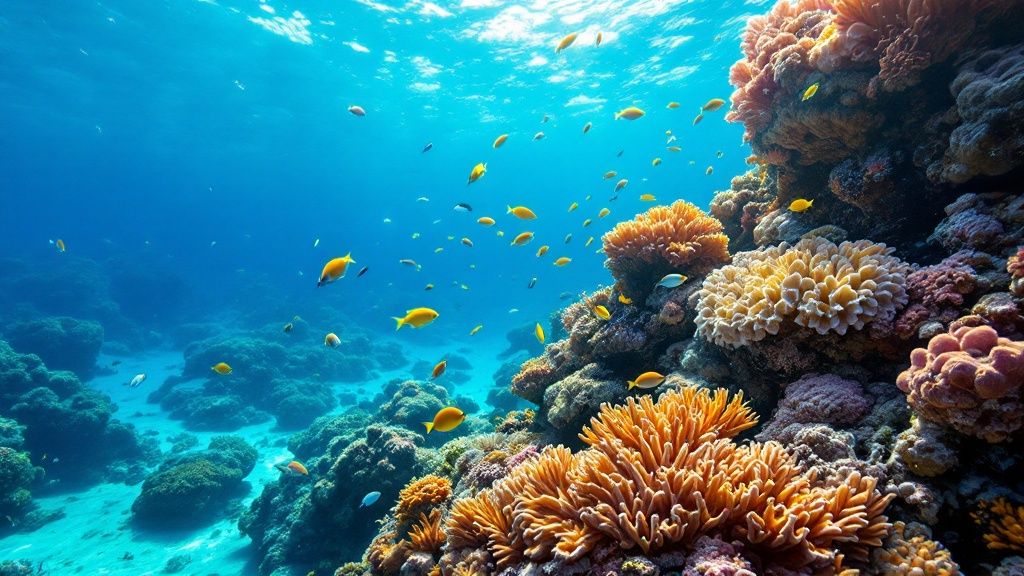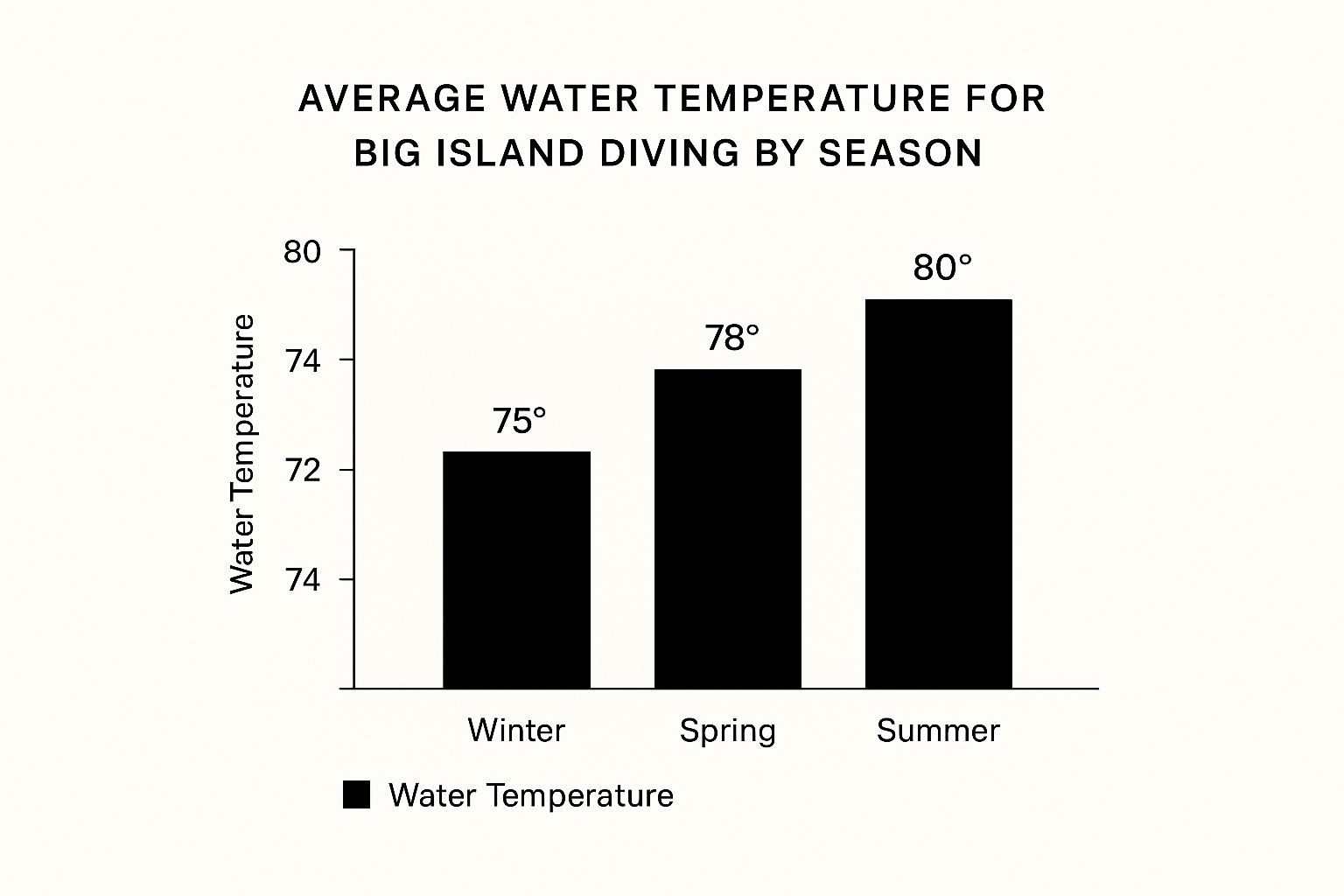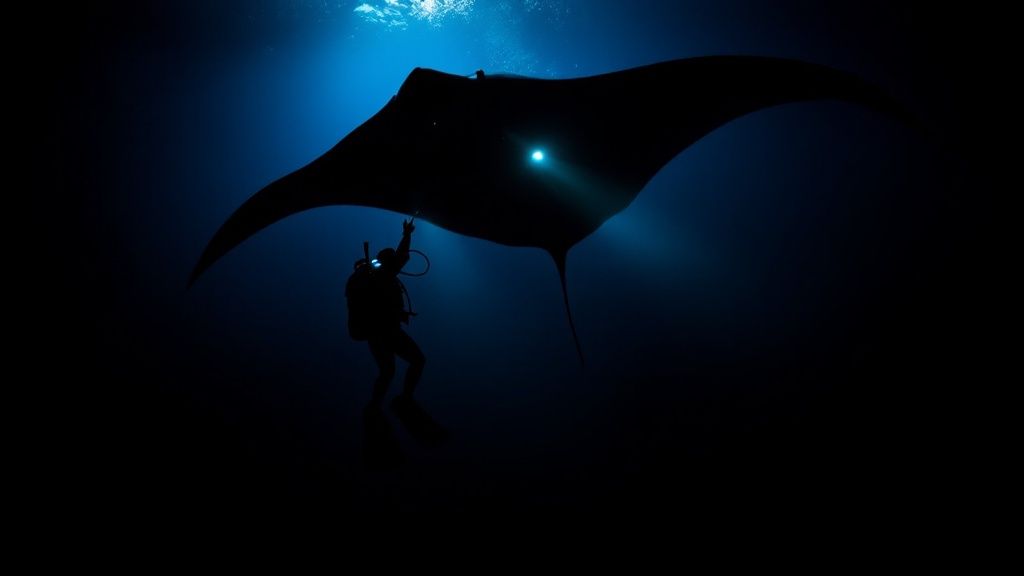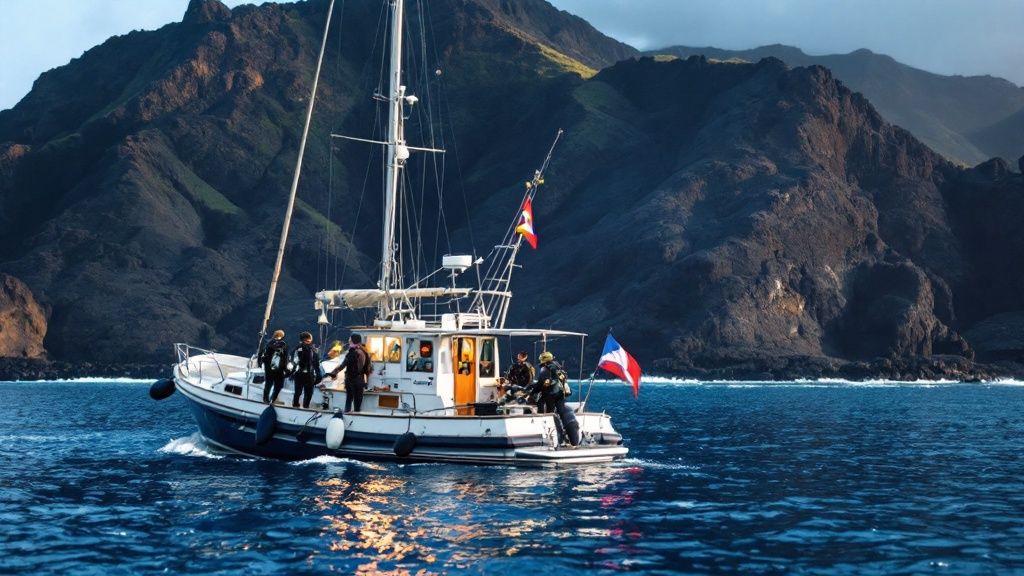The Allure of Big Island Diving: Beyond the Surface

The Big Island's volcanic foundation has created a truly unique underwater world. Solidified lava flows now form intricate caverns, arches, and pinnacles beneath the waves. This dramatic topography offers exceptional diving experiences, attracting divers of all skill levels. The remarkable water clarity, often exceeding 100 feet, allows for breathtaking views of vibrant coral reefs and diverse marine life.
Unveiling the Underwater Landscape
The Big Island's location in the middle of the Pacific Ocean contributes to its pristine diving conditions. The waters surrounding the island, far from major landmasses, are remarkably clear and free of sediment. This exceptional visibility, combined with the dramatic underwater structures, makes for a truly immersive diving experience. Exploring a lava tube, formed centuries ago by molten rock, is like stepping back in time. These tubes offer shelter to a variety of marine species, providing a unique glimpse into the island's geological and biological history.
The Big Island offers a rich diversity of dive sites. With over 1,000 distinct dive sites available, the Big Island of Hawaii is renowned for its extensive diving opportunities. This vast array of sites, ranging from shallow beginner-friendly areas like the Place of Refuge to more challenging dives for advanced divers, allows for the distribution of diver traffic. This distribution minimizes environmental impact and ensures a safe experience for all. Maintaining the health of marine ecosystems and ensuring sustainable diving practices are crucial. Big Island Divers Hawaii, for example, focuses on small group sizes to offer personalized experiences while emphasizing environmental responsibility.
Why Big Island Diving Stands Apart
Beyond the exceptional visibility and unique underwater terrain, diving off the Big Island offers incredible opportunities to encounter diverse marine life. Every dive holds the promise of a new discovery, from graceful manta rays gliding through the night waters to vibrant reef fish darting amongst the coral. Whether you're a seasoned diver looking for a thrilling adventure or a beginner eager to explore a new world, the Big Island has something to offer. This combination of accessibility, biodiversity, and stunning underwater beauty is what draws divers back to the Big Island year after year.
Essential Big Island Dive Sites You Can't Miss
Big Island diving offers incredible variety. Imagine vibrant coral gardens teeming with life, alongside dramatic volcanic landscapes. But what makes a dive site truly special? Exceptional visibility, unique underwater topography, and encounters with rare marine life all contribute to an unforgettable experience. Let's explore some of the Big Island's best dive locations, each offering a unique glimpse into this underwater paradise.
Kona Coast Gems: Manta Rays and More
The Kona Coast is famous for its manta ray night dives, a truly magical experience. At Manta Village and Manta Heaven, divers settle on the ocean floor to watch these gentle giants perform their graceful underwater ballet. The mantas feed on plankton, drawn in by the dive lights. Their sheer size and elegance is breathtaking.
For daytime adventures, Garden Eel Cove (also known as Manta Heaven) offers fascinating dives. Explore lava formations and watch the namesake garden eels sway rhythmically in the current. Check out our guide on the best shore diving sites in Kona.
Exploring Historic Kealakekua Bay
Further south, Kealakekua Bay provides a dive into history and nature. Explore the Captain Cook Monument, commemorating the explorer who first landed on the Big Island. The bay's calm, clear waters also boast vibrant coral reefs and a variety of fish, making it a great spot for both snorkelers and divers.
South Point's Dramatic Drop-Offs
Experienced divers will find a thrill at South Point, the southernmost point in the United States. Here, you can experience exhilarating drift dives along dramatic drop-offs. Strong currents carry divers along walls teeming with marine life, from colorful reef fish to pelagic species. Keep an eye out for larger marine animals like dolphins and sharks.
A Look at Seasonal Temperatures for Big Island Diving

This chart shows the average water temperatures for Big Island diving throughout the year. The water temperature gradually increases from a comfortable 75°F in winter to 78°F in spring, reaching a peak of 80°F in summer. These pleasant temperatures make diving enjoyable year-round.
Choosing the Right Dive for Your Skill Level
The Big Island caters to divers of all skill levels. Two Step, a popular shore dive near Kona, is ideal for beginners with its easy entry and shallow depths.
More experienced divers can explore the intricate lava tubes and caverns found at many sites. Or, try the unique experience of a Pelagic Magic blackwater dive, where you'll encounter bizarre deep-sea creatures.
To help you choose the perfect dive site, we've compiled a comparison table:
Big Island Dive Site Comparison
A comprehensive comparison of major dive sites around the Big Island, helping divers choose locations that match their skill level and interests
| Dive Site | Depth Range | Visibility | Experience Level | Marine Life Highlights | Best Time to Visit |
|---|---|---|---|---|---|
| Manta Village | 10-40ft | 50-100ft | Beginner – Advanced | Manta Rays, Reef Fish | Night dives |
| Manta Heaven/Garden Eel Cove | 15-50ft | 40-80ft | Beginner – Advanced | Manta Rays, Garden Eels, Lava Formations | Day/Night |
| Kealakekua Bay | 10-60ft | 50-100ft | Beginner – Intermediate | Coral Reefs, Diverse Fish, Captain Cook Monument | Year-round |
| South Point | 30-80+ft | 60-100+ft | Advanced | Pelagic Species, Reef Fish, Dolphins, Sharks | Year-round |
| Two Step | 5-20ft | 30-60ft | Beginner | Reef Fish, Easy Entry | Year-round |
This table highlights the diverse offerings of Big Island dive sites, from shallow reefs perfect for beginners to deeper, more challenging dives for experienced adventurers.
Big Island Divers Hawaii is a respected dive operator offering affordable options, with prices starting around $129 per person. Their small group focus ensures personalized guidance, allowing for a deeper understanding of the marine environment. Visibility often exceeds 100 feet, and the volcanic topography of the Kona coast creates a stunning underwater landscape. You can also find helpful tips in our guide to shore diving in Kona. With so many options, every diver is sure to find the perfect site to match their skill and comfort level.
Face-to-Face with Hawaii's Marine Residents

Big Island diving offers more than just stunning volcanic seascapes. It's a chance to connect with the incredible marine life that thrives in these waters. Every dive presents a unique opportunity, from interactions with gentle giants to observing the smallest reef dwellers. Big Island diving is truly an experience rich in biodiversity. Let's explore the fascinating world beneath the waves.
The Magic of Manta Rays
Manta rays are iconic residents of the Big Island. These graceful creatures, with wingspans reaching up to 18 feet, navigate the ocean currents with effortless elegance. Witnessing them feed at night is an experience you won't soon forget. Curious about this unique experience? Learn more about what a manta ray night dive entails: What is a manta ray night dive?
Plankton forms the core of their diet, and these gentle giants are often drawn to dive lights, where plankton gather. At popular dive sites like Manta Village and Manta Heaven, divers can observe these magnificent creatures up close as they perform their mesmerizing feeding dance, often coming within inches of onlookers.
Encounters with Other Marine Life
Manta rays aren't the only stars of the show. Big Island diving offers a wealth of encounters with other fascinating species. Hawaiian green turtles, locally known as honu, graze peacefully on algae-covered rocks. The vibrant endemic Hawaiian butterflyfish, with its distinctive markings, adds a splash of color to the coral reefs. And for the keen observer, the well-camouflaged frogfish, a master of disguise, might just reveal itself.
Spinner dolphins are also frequent visitors to the waters surrounding the Big Island. Known for their acrobatic leaps and spins, these playful creatures provide a thrilling spectacle for lucky divers. Such encounters create lasting memories and showcase the remarkable diversity of the region's marine life.
Seasonal Wonders and Adaptations
The Big Island diving experience changes with the seasons. Winter brings the arrival of majestic humpback whales, migrating from Alaska to breed and calve in the warmer Hawaiian waters. Summer, in contrast, marks the breeding season for many tropical fish, leading to vibrant aggregations and increased activity on the reefs.
The creatures inhabiting these waters have evolved remarkable adaptations to thrive in this unique volcanic environment. Some fish species, for example, have developed specialized mouthparts to graze on algae growing on the lava rocks. This highlights the close relationship between the marine life and the distinct geological features of the Big Island.
The exceptional water clarity, often exceeding 100 feet, allows sunlight to penetrate deep, fostering a diverse ecosystem of coral and plant life. This, in turn, provides habitat for a multitude of species.
However, these delicate ecosystems face growing challenges. Rising water temperatures and ocean acidification, both linked to climate change, pose a threat to coral reefs and the delicate balance of marine life. This underscores the importance of responsible diving practices and ongoing conservation efforts to protect these precious underwater environments for generations to come. Understanding these challenges helps divers appreciate the fragility of the ecosystem and promotes responsible interactions with the marine environment.
Diving Responsibly: Safety in Hawaii's Waters
Big Island diving offers an incredible experience. However, prioritizing safety is paramount. While stunning, Hawaii's waters present unique challenges. Divers must be well-prepared for these challenges, which include understanding potential hazards like currents and fluctuating water temperatures. Reputable dive operators play a crucial role in mitigating these risks and ensuring everyone's safety.
Understanding Dive Safety Protocols
Professional dive operators on the Big Island adhere to strict safety measures, often surpassing industry standards. Meticulous pre-dive assessments and the use of continuous monitoring systems are just two examples of these practices. This focus allows divers to explore the underwater world with confidence.
The Big Island's diving industry emphasizes safety and environmental responsibility. Big Island Divers, for example, maintain an excellent safety record. They also prioritize sustainable practices like site rotation and the use of reef-safe sunscreen. From introductory dives to advanced explorations, the Big Island offers a variety of experiences for all skill levels. You can find more detailed statistics at their website.
Recognizing Reputable Dive Operations
Choosing a reputable dive operator is critical for a safe and enjoyable diving experience. Look for operators who prioritize small group sizes and provide comprehensive pre-dive briefings. Experienced guides familiar with the local conditions are also essential. Your safety in Hawaii's waters is your responsibility.
Ask specific questions about their safety procedures, emergency protocols, and equipment maintenance. Inquire about the staff's certifications and experience. A responsible operator will be transparent and readily address your concerns. For instance, a good question to ask is how they handle dives when currents or visibility change. For more safety information you might find these Aviation Safety Tips insightful, though keep in mind they are related to aviation, some principles can be transferred.
Addressing Common Misconceptions and Managing Risks
Several misconceptions exist regarding Hawaiian diving hazards. Some mistakenly believe that all Hawaiian waters are calm and predictable. Others underestimate the potential impact of changing water temperatures on their dive. Understanding these misconceptions and implementing practical risk management strategies is essential.
Proper buoyancy control, planning dives within your limits, and adhering to the buddy system are fundamental safety practices. Knowing how to respond to unexpected situations, such as equipment malfunctions or encountering strong currents, is also vital. Learning to freedive can also enhance your underwater experience and confidence.
Protecting Hawaii's Reefs: Sustainable Diving Practices
Responsible diving in the Big Island goes beyond personal safety; it includes environmental stewardship. Divers can minimize their impact on Hawaii's fragile reefs by avoiding contact with coral, using reef-safe sunscreen, and properly disposing of any trash.
Supporting operators who embrace sustainable practices, such as using mooring buoys instead of anchoring directly on the reef, helps preserve these vital ecosystems. By diving responsibly, we contribute to the long-term health of Hawaii's reefs, ensuring their beauty for future generations. This helps to ensure that the joy of Big Island diving can be enjoyed for years to come.
Crafting Your Ultimate Big Island Diving Itinerary

Turning your Big Island diving dreams into an unforgettable trip starts with a solid plan. This means considering everything from where you'll base yourself to which dive operator you choose. A well-crafted itinerary helps you maximize your time underwater while still enjoying the island's topside attractions.
Choosing Your Dive Base: Kona Vs. Other Locations
The first step? Deciding where to set up camp. Kona, on the west coast, boasts calm, clear waters. This makes it a favorite for both new divers and seasoned pros. The east coast offers a different experience. The conditions can be more challenging, but rewarding for adventurous divers. Each area boasts unique underwater landscapes and marine life, so consider your skill level and what you want to see.
Selecting the Perfect Dive Operator
Once you've chosen your location, finding the right dive operator is key. Think about their specialties. Some focus on underwater photography, while others concentrate on marine biology education or adventure dives. Researching different operators and reading reviews helps you find the perfect match. Check out this resource for Top-Rated Kona Dive Shops.
Balancing Dive Time with Surface Intervals
When planning your dive schedule, remember to balance your underwater explorations with adequate surface intervals. This allows your body time to off-gas and prevents decompression sickness. Don't forget to factor in time for relaxation, exploring the island, and soaking up the Hawaiian atmosphere.
Gear Logistics: Rent or Bring Your Own?
Another important decision: renting gear or bringing your own. Renting is certainly convenient and avoids baggage fees. However, bringing your own familiar gear offers comfort and a sense of control. Weigh the pros and cons based on your travel style and the type of diving you plan to do.
Maximizing Your Dive Experience with Packages
Multi-day dive packages can offer significant cost savings and simplify logistics. They usually include tanks, weights, and sometimes even transportation to and from dive sites. These packages can free up your time so you can focus on enjoying your dives.
Integrating Diving into Your Overall Hawaiian Vacation
Think about how your diving fits into your overall Hawaiian vacation. Researching the best time of year for diving, based on weather and marine life migrations, helps ensure optimal conditions. Also, factor in travel time between dive sites and other attractions.
To help you plan your underwater adventures, check out this helpful table:
Big Island Diving Seasons Guide
Monthly breakdown of diving conditions, visibility, water temperature, and special marine life encounters throughout the year
| Month | Water Temperature | Visibility | Weather Conditions | Special Marine Life Encounters |
|---|---|---|---|---|
| January | 74-78°F (23-26°C) | 50-75ft (15-23m) | Generally calm | Humpback whales |
| February | 73-77°F (23-25°C) | 50-75ft (15-23m) | Generally calm | Humpback whales |
| March | 73-77°F (23-25°C) | 50-75ft (15-23m) | Transition period | Manta rays |
| April | 74-78°F (23-26°C) | 60-80ft (18-24m) | Calmer seas | Whale sharks (occasional) |
| May | 76-80°F (24-27°C) | 70-90ft (21-27m) | Warmer waters | Reef fish spawning |
| June | 78-82°F (26-28°C) | 70-90ft (21-27m) | Sunny and dry | Green sea turtles nesting |
| July | 80-84°F (27-29°C) | 80-100ft (24-30m) | Hottest month | Pelagic fish |
| August | 81-85°F (27-29°C) | 80-100ft (24-30m) | Hot and humid | Spinner dolphins |
| September | 80-84°F (27-29°C) | 70-90ft (21-27m) | Hurricane season starts | Hammerhead sharks (occasional) |
| October | 78-82°F (26-28°C) | 60-80ft (18-24m) | Variable conditions | Manta rays |
| November | 76-80°F (24-27°C) | 50-75ft (15-23m) | Cooler temperatures | Humpback whales begin arriving |
| December | 74-78°F (23-26°C) | 50-75ft (15-23m) | Winter conditions | Humpback whales |
This table offers a general overview; conditions can vary. Always check with your dive operator for the most up-to-date information.
By planning carefully, you can seamlessly blend underwater adventures with exploring the island's volcanic landscapes, lush rainforests, and vibrant culture. This creates a truly unforgettable Hawaiian getaway.
Between Dives: Complementary Big Island Experiences
Maximizing your Big Island adventure involves strategically planning your surface time to complement your underwater explorations. Thoughtfully chosen land-based activities can enrich your understanding of the island's marine environment while providing essential dive recovery time.
Exploring Volcanic Landscapes and Cultural Connections
The volcanic forces that shaped the Big Island's dramatic underwater topography are also readily visible on land. A visit to Hawaii Volcanoes National Park offers the opportunity to witness active volcanic activity and explore lava tubes, formations that mirror those you might encounter on dives. This powerful connection between land and sea fosters a more holistic understanding of the island’s geological history.
Hawaiian cultural sites also reveal a rich history of connection to the ocean. Many heiaus (temples) are located along the coast, demonstrating the profound spiritual respect early Hawaiians held for the sea. These cultural experiences offer invaluable insights into the traditions and values that continue to shape modern marine conservation efforts.
Snorkeling: Surface Adventures in a Marine Paradise
Snorkeling presents an excellent alternative way to experience the Big Island’s vibrant marine life without the need for full dive gear. This makes it a perfect activity for off-gassing days or for travel companions who aren't certified divers. Locations like Kealakekua Bay and Kahalu'u Beach Park, known for their calm waters and plentiful fish populations, are ideal for relaxing snorkeling excursions. You might be interested in learning more about Big Island scuba diving in fall.
Hiking, Lava Tubes, and Coastal Trails
Combining waterfall hikes, lava tube explorations, and coastal trails creates a multifaceted understanding of Hawaii’s unique island ecology. Hiking through lush rainforests to cascading waterfalls offers a different perspective on the island's water systems. Exploring lava tubes allows you to walk through the paths once flowed through by molten rock, creating a tangible connection to the island’s fiery origins. Coastal trails offer stunning ocean views, highlighting the dynamic relationship between land and sea.
Planning Your Surface Time: Transportation and Timing
Successfully managing your surface adventures requires careful consideration of transportation and timing. Renting a car allows for maximum flexibility to explore at your own pace. While public transportation is an option, it may limit your access to certain areas. Strategic planning of your activities can help you avoid large crowds, particularly at popular destinations such as Volcanoes National Park.
Engaging with Local Communities
Connecting with local communities can add significant depth to your Big Island experience. Many communities actively participate in marine conservation initiatives. Engaging with these groups through volunteer opportunities or educational programs offers valuable perspective on the challenges and triumphs of protecting the island’s fragile environment. It’s also a way to give back to the island and support those dedicated to preserving its natural beauty.
For a truly memorable Big Island experience, plan your surface time strategically, combining land-based adventures with your diving excursions. This approach will deepen your appreciation for the island’s unique environment and create lasting memories that extend far beyond your underwater explorations.
Ready to begin your Big Island diving adventure? Book your dives and discover the magic of the underwater world with Kona Honu Divers. We offer a range of experiences, from beginner courses to advanced excursions, ensuring an unforgettable experience for every diver.
